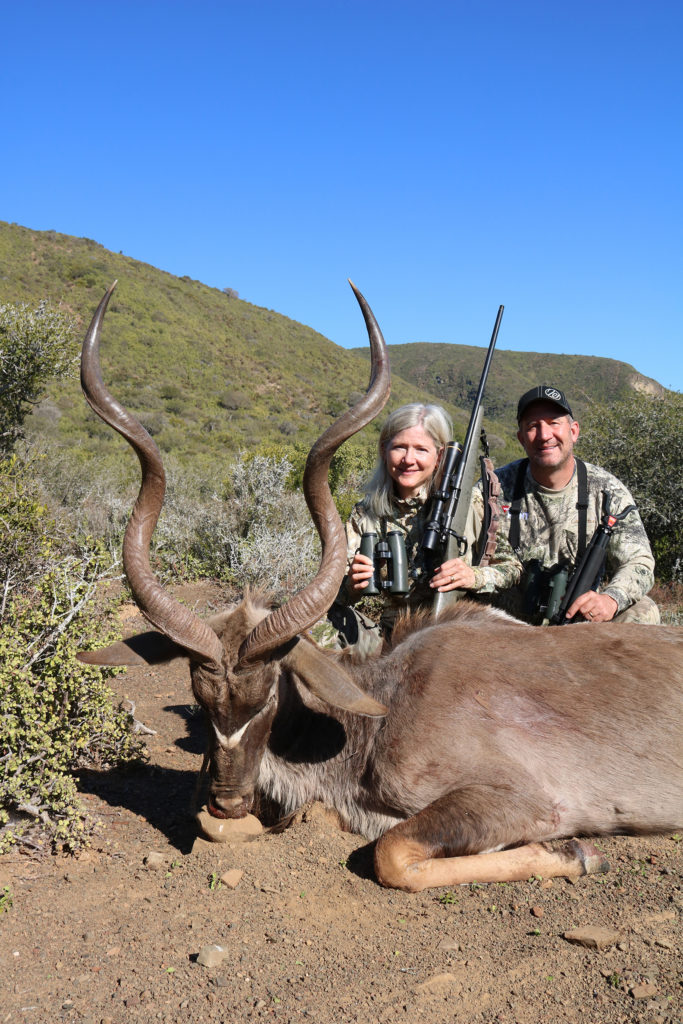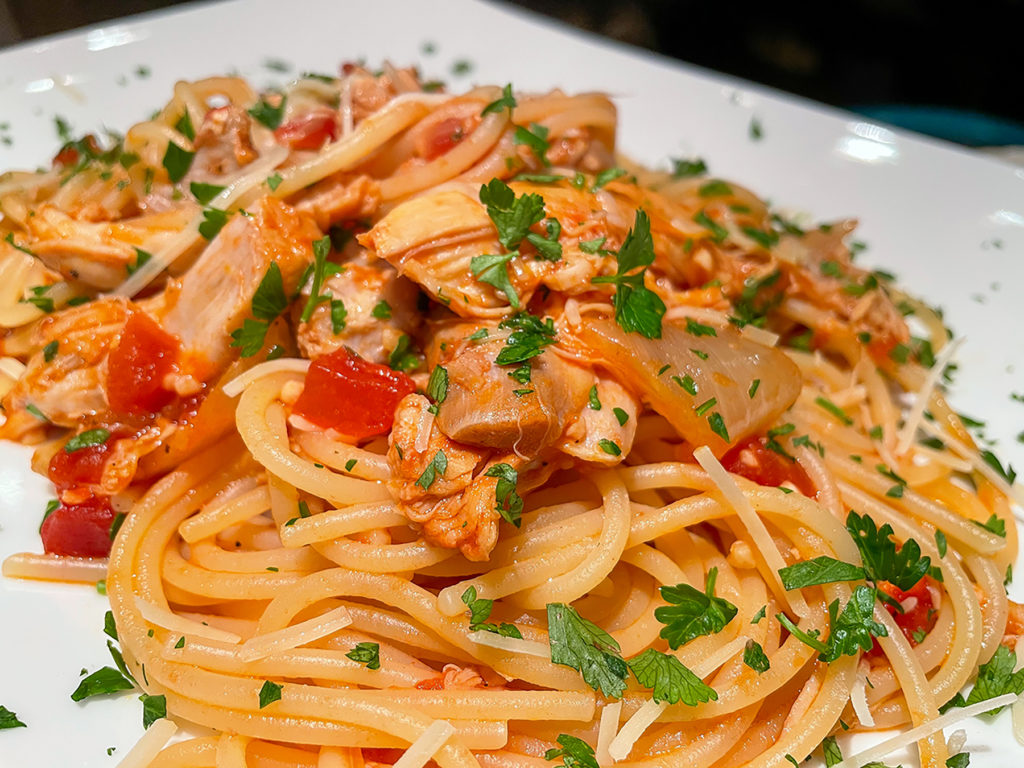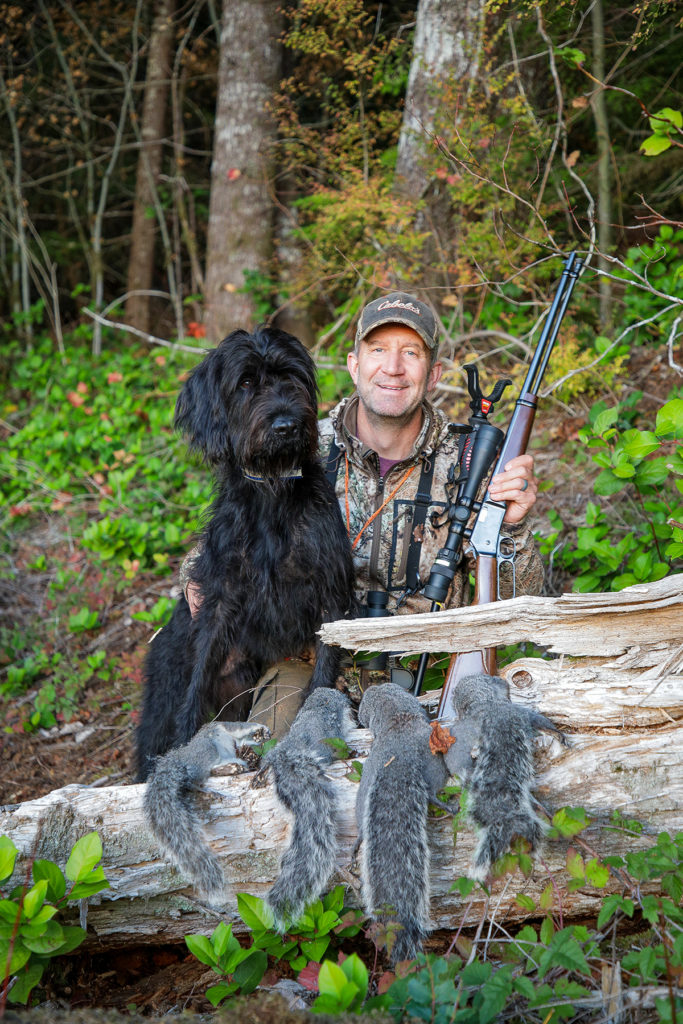Love (Outdoors) American Style: A Partnership For Life And In Business
The following appears in the February issue of California Sportsman:

In 32 years of marriage and as partners in the outdoors industry, Scott and Tiffany Haugen have shared plenty of adventures. One of the most enjoyable hunts for the Haugens is fall turkey hunting with their dog, Echo, a pudelpointer. (SCOTT HAUGEN)
BY SCOTT HAUGEN
We met in first grade. Our parents grew up together. Our grandparents even knew one another.
I didn’t talk to Tiffany Fountain much during our years in elementary, middle and high school. But we did meet for dinner one evening after graduating from college – her from Oregon State University, me from the rival University of Oregon.
“What are you going to do with your teaching degree?” she asked. “Move to the Alaskan Arctic, where I can teach in a tiny village and learn to hunt and trap with the Inupiat Eskimo peoples,” I replied.
She looked at me and offered, “You better do it now while you’re young and single, because no woman will follow you up there!”
Tiffany had also earned an education degree. Four months later we were engaged. Nine months later we were married and teaching school in one of the tiniest locations on the Arctic coast.

WE’VE BEEN MARRIED NEARLY 32 years and our lives have never slowed down. After teaching in small schools for seven years in the Arctic, we moved to Sumatra, Indonesia, where we taught at an international school for four years. We started our own family and eventually moved back home to Walterville, Oregon, east of Eugene.
In 1997 I started dabbling in outdoor writing. My first book, Hunting The Alaskan High Arctic, became an all-time best seller for the publisher. By 2001 I felt I could make a living in the outdoor industry as a full-time writer. I made $11,000 that year. But I was forming valuable relationships and soon speaking opportunities and TV hosting jobs came along. The timing was right.
Before I knew it, I was traveling the world hunting and fishing and hosting multiple TV shows. My writing career also boomed. Some years I was in the field over 280 days. Then, when hunting season was over, the speaking circuit began, and that’s where Tiffany came in.
Though Tiff and our two sons joined me on many hunting and fishing trips and were part of the TV shows, it was Tiffany’s ability as a wild game cook that paved her way into the industry. During our time in Alaska we ate only the meat we caught and killed. We ate fish and game every single day. We did – and have always done – our own butchering. With Tiff’s cooking abilities and vast diversity, she was quickly in high demand by companies in the outdoor industry.
Soon we were speaking three months of the year at big events like the NRA Convention and many sport shows around the country. One weekend we’d be in Charlotte, another in Sacramento or Portland, Las Vegas or Nashville, and more. I offered seminars on hunting and fishing techniques, while Tiff gave many on wild game cooking.
But our favorite seminars were when we worked together. Oftentimes whole deer or pigs were brought; we butchered the entire animal, and then Tiff would work her magic, whipping up some great recipes to feed the attendees. To this day she’s the best cook I’ve ever met. We still eat wild game and fish every day. I don’t like going to restaurants because they’re never as good as what Tiffany cooks up.
Together, we’ve written over 20 books, mine on hunting and fishing, Tiff’s on cooking wild game and fish. The cookbooks take the most work. Her popular Cooking Game Birds book was six years in the making; that’s how long it took for her to get things exactly the way she wanted them when it came to wild birds.
When she’s in cooking mode, Tiffany is often preparing a half-dozen recipes a day, and having test cooks replicate recipes, as well as taste-testers give her feedback.

OVER THE YEARS, OUR workload has expanded to include photography, marketing and more. We often work 16 hours a day, each, usually side by side when at home. It’s been far from easy, but I would not change any of it. The times we spend together – as a family butchering a whole elk, deer or bear – are experiences none of us will forget. Traveling the world and filming TV shows in Africa, the South Pacific and Alaska were a blessed opportunity. From the time our boys were small they were hunting, fishing and helping butcher animals.
We got into the outdoor industry at a prime time and just happened to be the team some key companies were looking for. Had we not been able to work with each other all these years, there’s no way I could have done it alone.
One fall, I was home just eight days between the hunting season opener of August 1 and Christmas. Tiff had the hardest part at that time to be home alone with our two young sons. But she always supported me and never questioned the direction we were going.
Each passing year led to more opportunities. When I was on the road, Tiffany was going full speed ahead on her cookbooks, cooking columns and working with many companies in the outdoor industry while developing recipes and cooking equipment, even women’s clothing lines.
I fell in love with Tiffany at our first dinner many years ago because of her confidence and zest for seeking adventure. No challenge is too great for her. Her confidence has never waned, and to this day she’s the hardest-working, most positive person I’ve ever met.
I RECENTLY WAS IN a hunting camp. And while I don’t often share personal stories, the people in this camp were particularly interested in hearing how I am a survivor of a plane crash and a sunken boat in remote Alaska, was charged by a brown bear, covered with leeches in the Australian Outback, and more. “Wow,” one man exclaimed, “that’s mind-boggling to even imagine. So, what’s your greatest fear: drowning, being eaten by a bear, or dying in a plane crash?” he asked.
I looked him in the eye. “My greatest fear isn’t dying. My greatest fear is having something happen to my best friend, Tiffany.”
Enjoy this Valentine’s Day and embrace the one you love. ASJ
Editor’s note: For signed copies of Scott Haugen’s popular books, visit scotthaugen. com. Follow Scott on Instagram and Facebook.

RECIPE: ENJOY ‘THE CHICKEN OF THE TREES”
By Tiffany Haugen
With a growing interest in people hunting as a way of putting protein on the table, don’t overlook the little critters.
California has four species of tree squirrels that can be hunted during designated seasons, with the Western gray squirrel being our favorite to eat. Super versatile, squirrel can be cooked up just about any way you like. And yes, it does taste a bit like chicken, or maybe more like a young wild turkey.
Low and slow or pressure cooked is an ideal way to cook up all cuts of a squirrel. Because squirrel is incredibly lean meat, it’s best cooked using a moist heat method. We don’t cook them whole because they are much easier to cook once segmented. Simply butcher off the saddle, hind and front quarters and put in a slow cooker or pressure cooker (Instant Pot).
This is an easy, foolproof recipe that will bring out the best flavor for your recent quarry of “chicken of the trees.” This recipe also works well with brush rabbits and cottontails.
2 to 3 pounds bone-in or boneless squirrel (or rabbit) meat
One 10-ounce jar Rotel diced tomatoes and green chilies*
One 6-ounce can tomato paste
One medium onion, chopped
4 to 6 cloves garlic, peeled
½ cup water
¼ cup apple cider vinegar
1 teaspoon salt
½ teaspoon black pepper
½ stick butter
¼ cup fresh chopped parsley and/or basil
Parmesan cheese if desired
Place squirrel, Rotel, tomato paste, onion, garlic, water, vinegar, salt and pepper in a slow cooker or pressure cooker. Mix well, coating squirrel with tomato mixture. In a slow cooker, cook for four to six hours on high or until squirrel meat falls from bones. In a pressure cooker, set pressure to high and cook 11 minutes for boneless squirrel and 15 minutes for bone-in squirrel pieces. Let pressure release on its own before checking for doneness.
When squirrel meat is done, remove bones from the meat and add butter and fresh chopped herbs. Let sauce continue to simmer and reduce while making spaghetti noodles. Cook spaghetti according to package directions and add to sauce before serving. Garnish with Parmesan cheese and more fresh herbs if desired.
*For more sauce, or a Rotel substitution, use a 14.5-ounce can diced tomatoes and an 8-ounce can diced roasted green chilies in place of the Rotel.
Editor’s note: For signed copies of Tiffany Haugen’s popular book, Cooking Big Game, send a check for $20 to Haugen Enterprises, P.O. Box 275, Walterville, OR 97489, or visit scotthaugen.com for this and other titles.




